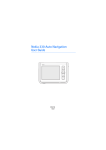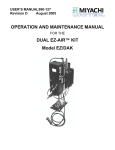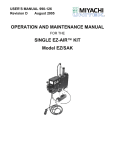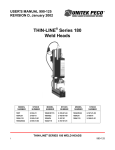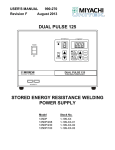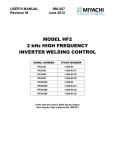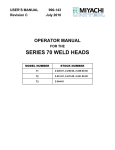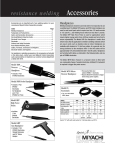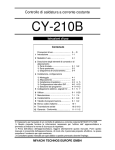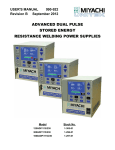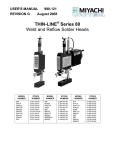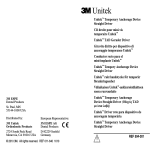Download THERMOCOUPLE WELDER - AMADA MIYACHI AMERICA
Transcript
USER'S MANUAL 990-070 Revision C December 2011 THERMOCOUPLE WELDER Copyright © 1990, 2002, 2007 Miyachi Unitek Corporation The engineering designs, drawings and data contained herein are the proprietary work of MIYACHI UNITEK CORPORATION and may not be reproduced, copied, exhibited or otherwise used without the written authorization of MIYACHI UNITEK CORPORATION. Printed in the United States of America. Revision Record Revision EO Date Basis of Revision 5/90 Original Manual A 19161 2/02 1. Add Unitek Peco™ name 2. Update manual B 21443 6/07 Correct error in Table of Contents and update to Miyachi Unitek corporate logo. C 41646 12/11 Updated to Miyachi Unitek labeling THERMOCOUPLE WELDER ii 990-070 FOREWORD Thank you for purchasing a Miyachi Unitek Thermocouple Welder. Upon receipt of your equipment, please thoroughly inspect it for shipping damage prior to its installation. Should there be any damage, please immediately contact the shipping company to file a claim, and notify Miyachi Unitek Corporation at: 1820 South Myrtle Avenue P.O. Box 5033 Monrovia, CA 91017-7133 Telephone: (626) 303-5676 FAX: (626) 358-8048 e-mail: [email protected] The purpose of this manual is to supply operating and maintenance personnel with the information needed to properly and safely operate and maintain the Thermocouple Welder. We have made every effort to ensure that the information in this manual is accurate and adequate. Should questions arise, or if you have suggestions for improvement of this manual, please contact us at the above location/numbers. Miyachi Unitek Corporation is not responsible for any loss due to improper use of this product. THERMOCOUPLE WELDER 990-070 iii SAFETY NOTES This instruction manual describes how to operate, maintain and service the Thermocouple Welder, and provides instructions relating to its SAFE use. Procedures described in this manual MUST be performed, as detailed, by QUALIFIED and TRAINED personnel. For SAFETY, and to effectively take advantage of the full capabilities of the tester, please read these instruction manuals before attempting to use the workstation. Procedures other than those described in this manual or not performed as prescribed in it, may expose personnel to electrical hazards. After reading this manual, retain it for future reference when any questions arise regarding the proper and SAFE operation of the tester. Please note the following conventions used in this manual: WARNING: Comments marked this way warn the reader of actions which, if not followed, might result in immediate death or serious injury. CAUTION: Comments marked this way warn the reader of actions which, if not followed, might result in either damage to the equipment, or injury to the individual if subject to long-term exposure to the indicated hazard. THERMOCOUPLE WELDER iv 990-070 CONTENTS Page Revision Record ......................................................................................................................................... ii Foreword ................................................................................................................................................... iii Safety Notes .............................................................................................................................................. iv CHAPTER 1: SYSTEM DESCRIPTION .......................................................................................... 1-1 Introduction .............................................................................................................................. 1-1 Power Supply ............................................................................................................................ 1-1 Description ........................................................................................................................ 1-1 Line Voltage ...................................................................................................................... 1-1 Line Current Ratings ......................................................................................................... 1-1 60/50 Hz Operation ........................................................................................................... 1-2 Standby Power ................................................................................................................... 1-2 Stored Energy Rating ........................................................................................................ 1-2 Welding Speed .................................................................................................................. 1-2 Capacitor Bank .................................................................................................................. 1-2 Line Voltage Regulator ..................................................................................................... 1-3 Turndown Circuit .............................................................................................................. 1-3 Line Failure Turndown ...................................................................................................... 1-3 Weld Fire Lockout ............................................................................................................ 1-3 Power Switch ..................................................................................................................... 1-3 Weld Ready ....................................................................................................................... 1-3 Wire Gauge Selector ......................................................................................................... 1-4 Physical Dimensions ......................................................................................................... 1-4 Handpiece Specifications ......................................................................................................... 1-4 Wire Gauge Diameter Specifications ................................................................................ 1-5 Initiation ............................................................................................................................ 1-5 Safety Features .................................................................................................................. 1-5 Physical Dimensions ......................................................................................................... 1-6 Argon Purge Gas ............................................................................................................... 1-6 Gas Flow ........................................................................................................................... 1-6 Argon Purge Gas Shutoff .................................................................................................. 1-7 THERMOCOUPLE WELDER 990-070 v CONTENTS (Continued) Page CHAPTER 2: INSTALLATION ......................................................................................................... 2-1 Section I. Power Supply Installation .............................................................................................. 2-1 Power Supply ............................................................................................................................ 2-1 Section II. Thermocouple Wire Preparation ................................................................................... 2-3 Insulation Stripping .................................................................................................................. 2-3 Handpiece Wire Clamping Jaws Installation ........................................................................... 2-4 Wire Clamp Jaw Removal and Insertion ........................................................................... 2-4 CHAPTER 3: OPERATING INSTRUCTIONS ................................................................................ 3-1 Section I. Operation ........................................................................................................................ 3-1 CHAPTER 4: USER MAINTENANCE ............................................................................................. 4-1 Section I. Handpiece Maintenance ................................................................................................. 4-1 Wire Clamp Jaws ...................................................................................................................... 4-1 Handpiece Cable Replacement ................................................................................................. 4-1 Section II. Weld Chamber Maintenance ......................................................................................... 4-4 CHAPTER 5: SERVICE ...................................................................................................................... 5-1 Section I. Calibration ...................................................................................................................... 5-1 Section II. Troubleshooting ............................................................................................................ 5-1 Thermocouple Weld is Dirty or Inconsistent ........................................................................... 5-1 Poor Welds or Failure to Weld ................................................................................................. 5-1 No Output ................................................................................................................................. 5-1 Thermocouple Stuck in Wire Clamp Tube ............................................................................... 5-1 Section III. Repair Service .............................................................................................................. 5-2 Technical Assistance ................................................................................................................ 5-2 Telephone Service ............................................................................................................. 5-2 Factory Service Repair ...................................................................................................... 5-2 ILLUSTRATIONS Figure Title Page 1-1 2-1 2-2 3-1 Front and Back Picture of TCW ........................................................................................ 1-2 TCW Schematic, Sheet 2, Power Connections ................................................................. 2-2 Wire Clamp Jaw Assembly ............................................................................................... 2-4 Thermocouple Wire Insertion Procedure .......................................................................... 3-1 THERMOCOUPLE WELDER vi 990-070 CHAPTER 1 SYSTEM DESCRIPTION Introduction The Miyachi Unitek™ Model TCW Thermocouple Welder, Stock Number 01-196-02, is a manual feed thermocouple welder designed to weld thermocouple wires together to form a thermocouple junction, uniform in size, and without detrimental oxide layers when used with argon cover gas. Four different size Wire Clamp Jaws, which are inserted into the TCW Handpiece, permit joining of most thermocouple wire materials that ranges in diameter from 38 AWG (.0040 inch) to 20 AWG (.0320 inch). The circuitry is solid state, with components conservatively rated when used within the maximum specified repetition rates. The unique charging circuit uses thyristors to provide high reliability and precise charging intervals. Operator safety is ensured through the use of multiple earth ground connections. Power Supply Description The Model TCW combines capacitor discharge power supply and Tungsten Inert Gas (TIG) welding technology to make a thermocouple junction. Line Voltage Line voltage is 115, 208, or 230 Volts, 60/50 Hz. The Thermocouple Welder (TCW) is a multi-voltage unit is normally connected for 115V, 60/50 Hz operation unless otherwise specified on the nameplate and the label attached to the line cord. The actual line voltage should be within ±13% of the nominal voltage for which the TCW is connected. Line Current Ratings Nominal Line Voltage (VRMS) 115 Line Voltage Range (VRMS) 100 – 130 Line Frequency Hz Circuit Breaker Size – Amps No. of Breakers Required 50/60 .5 1 208 230 180 – 235 200 – 260 50/60 50/60 .3 .3 2 2 THERMOCOUPLE WELDER 990-070 1-1 CHAPTER 1: SYSTEM DESCRIPTION 60/50 Hz Operation The TCW is a dual-frequency machine that does not require calibration for operation at 50 or 60 Hz. Standby Power Standby power is approximately 15 watts. Stored Energy Rating 1.5 to 190 watt-seconds (joules). Welding Speed The actual weld time is less than 0.1 seconds and the time for the circuitry to recharge is a maximum of 3 seconds. The maximum number of welds per minute is limited to how fast the Handpiece can be loaded and inserted into the Weld Chamber. Capacitor Bank The Capacitor Bank is 18,300 µ ± 5% at 20 degrees Celsius. At full rating, the Capacitor Bank is operated at 144 volts. Figure 1-1. Front and Back Views of Thermocouple Welder. THERMOCOUPLE WELDER 1-2 990-070 CHAPTER 1: SYSTEM DESCRIPTION Line Voltage Regulator The Line Voltage regulator ensures that the welds are independent of changes in line voltage by maintaining the voltage on the capacitor bank within ± 0.25% of setting for a ± 13% change in line voltage. Turndown Circuit The Turndown Circuit allows the user to reduce the energy setting by using the Wire Gauge Selection Control. The excess energy stored in the capacitor bank is dissipated internally. The Turndown Circuit dead-band is approximately 0.6% of the full scale voltage. Line Failure Turndown The Line Failure Turndown is a safety feature which ensures that the capacitor bank is automatically discharged whenever the input power is interrupted. Weld Fire Lockout This feature helps prevent poor welds by inhibiting firing of the TCW until the energy stored in the capacitor bank is within 1% of the pre-selected value. Power Switch A rocker switch disconnects both sides of the input power line when switched to the “OFF” position. Weld Ready A yellow lamp indicates that the capacitor bank has been charged or discharged to the proper voltage level and is ready to make a weld. Wire Gauge Selector The Wire Gauge Selector controls the level of stored energy necessary to make a thermocouple weld. Energy levels are indicated for each American Wire Gauge (AWG) from 38 AWG to 20 AWG. Because of variations in the thermocouple wire diameters and in the melting characteristics of the various thermocouple alloys, it may be necessary to increase or decrease the WIRE GAUGE SELECTOR setting to produce a good thermocouple weld. This control may also be used to increase or decrease the size of the weld bead to meet specific customer requirements. THERMOCOUPLE WELDER 990-070 1-3 CHAPTER 1: SYSTEM DESCRIPTION Physical Dimensions HEIGHT 6 7/8 inch (17.5 cm) WIDTH 10 ¼ inch (26.0 cm) DEPTH 10 inch (25.4 cm) WEIGHT 16.2 lbs ( 7.4 kg) Includes Handpiece Handpiece Specifications The Model TCW Handpiece is not supplied with any Wire Clamp Jaw Assemblies. A single Wire Clamp Jaw Assembly of the proper gauge is required to operate the TCW. Four Wire Clamp Jaw Assemblies are available for use with different gauge wires. The table below defines which Wire Clamp Jaw Assembly should be used with each wire diameter size. Wire Size AWG Stock No. Model No. ID No. 38-32 10-293-01 TCWCS38 1 31-27 10-294-01 TCWCS31 2 26-23 10-295-01 TCWCS26 3 22-20 10-296-01 TCWCS22 4 THERMOCOUPLE WELDER 1-4 990-070 CHAPTER 1: SYSTEM DESCRIPTION Wire Gauge Diameter Specifications The table below defines the maximum outer jacket insulation size for each wire gauge. It does not refer to the insulation covering each wire. Nominal AWG Wire Size Diameter Max Insulation Diameter inch mm inch mm 38 .0040 .1016 .038 0.97 37 .0045 .1143 .038 36 .0050 .1270 35 .0056 34 Nominal AWG Wire Size Diameter Max Insulation Diameter inch mm inch mm 28 .0126 .3200 .055 1.40 0.97 27 .0142 .3607 .055 1.40 .038 0.97 26 .0159 .4039 .124 3.15 .1422 .038 0.97 25 .0179 .4547 .124 3.15 .0063 .1600 .038 0.97 24 .0201 .5105 .124 3.15 33 .0071 .1803 .038 0.97 23 .0226 .5740 .124 3.15 32 .0080 .2032 .038 0.97 22 .0253 .6426 .159 4.04 31 .0089 .2261 .055 1.40 21 .0285 .7239 .159 4.04 30 .0100 .2540 .055 1.40 20 .0320 .8128 .159 4.04 29 .0113 .2870 .055 1.40 Initiation The Handpiece must be correctly inserted into the Weld Chamber to initiate firing. The two thermocouple wires loaded in the Handpiece must touch the Arc Button located inside the Weld Chamber in order to initiate a weld. The firing sequence ensures that the Handpiece is double earth grounded for maximum operator safety. Internal power supply filtering prevents premature firing due to radio frequency interference. Safety Features Double earth grounded techniques eliminate the possibility of electrical shock to the operator. The Handpiece used to hold the thermocouple wires is earth grounded to the TCW chassis using a nonremovable cable. The length of the cable prevents injury to the Handpiece should it fall off a table or bench that is a minimum of 30 inches high. When the Handpiece is placed in the Weld Chamber, a solenoid mechanically clamps the Handpiece, creating a second earth ground path. THERMOCOUPLE WELDER 990-070 1-5 CHAPTER 1: SYSTEM DESCRIPTION Physical Dimensions BODY LENGTH 4 inch (10.16 cm) BODY DIAMETER ¾ inch ( 1.91 cm) WIRE CLAMP LENGTH ¾ inch ( 1.91 cm) WIRE CLAMP DIAMETER ¼ inch ( 0.64 cm) WEIGHT .2 lbs (91 gm) Argon Purge Gas Thermocouple welding is performed in an argon filled Weld Chamber which is located on the center, upper face of the TCW. Argon purge gas is necessary to prevent thermocouple joint oxidation during the welding process. NOTE: Nitrogen is not effective as a purge gas. Gas Flow 3 cubic feet per hour, nominal. Argon Purge Gas Shutoff An internal solenoid valve blocks the flow of argon purge gas to the Weld chamber when input power to the TCW is turned off. NOTE: For this system to be economical, the user must eliminate all leaks in the gas system feeding the Model TCW. When the input power is on, gas flow is continuous. An internal gas reservoir, located between the purge gas input connector and the shutoff solenoid, stores a sufficient amount of argon purge gas to immediately clear out the Weld Chamber when the TCW is turned back on. THERMOCOUPLE WELDER 1-6 990-070 CHAPTER 2 INSTALLATION Section I. Power Supply Installation Power Supply CAUTION: Do not connect the Thermocouple Welder to the power line at this time. Check the voltage label on the line cord. At the time of shipment, the voltage for which the Thermocouple Welder was connected was marked on the line cord. Do not connect the Thermocouple Welder to any voltage without properly changing the internal connections. The TCW was assembled at the factory for operation at a specific line voltage. If the TCW is used on a line voltage other than the one for which it is connected, serious damage can result. Most Thermocouple Welders are shipped from the factory wired for 115 volt, 50/60 Hz operation. To check whether the TCW is connected for 115 or 230 volts, follow steps below: • Turn the WIRE GAUGE SELECTOR fully counter-clockwise to 40. Verify that the POWER switch is in the “OFF” position and that the line cord is disconnected. • If power was previously applied, wait one minute to ensure that the Capacitor bank is fully discharged. • Loosen the four screws which secure the cover and lift the cover straight up to remove it. The different transformer connections and circuit breakers for each specific line voltage are illustrated in figure 2-1. • Replace the cover and tighten the screws. Change the line cord plug, if necessary. If necessary, change or replace the voltage label on the line cord to show the correct operating voltage. Miyachi Unitek recommends that the Thermocouple Welder (TCW) be installed in a well ventilated area, free of dirt and moisture. The Thermocouple Welder is a self contained unit designed to minimize installation and setup time. Connect the Purge Gas Inlet Port, located on the rear panel of the TCW, to a PROPERLY FILTERED ARGON GAS SUPPLY using 0.25” O.D. x 0.17” I.D., 120 PSI, plastic tubing. Turn ON the purge gas supply. Set the Pressure Regulator to 50 PSIG. Set the Flow Regulator for 3 cubic feet per hour. Repair leaks, if necessary. THERMOCOUPLE WELDER 990-070 2-1 CHAPTER 2: INSTALLATION (L2) TO 115VAC SOLENOID VALVE Primary Wiring for 115VAC Models CB1 0.05A C2 0.005 S1A 1 T1 6 C1 0.01 2 P1 S1B 7 8 3 4 9 10 5 J14 (L2) TO 115VAC SOLENOID VALVE Primary Wiring for 208VAC Models CB1 0.03A C2 0.005 1 T1 6 C1 0.01 CB2 0.03A P1 S1A 2 S1B 7 8 3 4 9 10 5 J14 (L2) TO 115VAC SOLENOID VALVE Primary Wiring for 230VAC Models CB1 0.03A C2 0.005 P1 S1A 1 T1 6 C1 0.01 CB2 0.03A 2 S1B 3 4 7 8 9 5 10 J14 Figure 2-1. Power Supply Connections THERMOCOUPLE WELDER 2-2 990-070 CHAPTER 2: INSTALLATION Section II. Thermocouple Wire Preparation Insulation Stripping The jacket insulation and the insulation covering both thermocouple wires must be stripped back a MINIMUM distance from the end of the wire where the weld is to take place. Proper removal of the insulation allows the bare thermocouple wires to protrude a minimum distance from the end of the Handpiece Wire Clamping Jaws. Mechanical strippers with oval shaped cutters work best. Do not use Thermal Strippers with Teflon Coated Wires. Thermal stripping Teflon leaves a thin Teflon coating on the wires, preventing weld current from flowing. When properly stripped, the bare thermocouple wires will be of equal length, parallel, and free of insulation residue. The table below gives the minimum wire stripping length for each wire size. Wire Size AWG Stock No. Model No. ID No. Strip Length Inches Strip Length MM 38 – 32 31 – 27 26 – 23 22 – 20 10-293-01 10-294-01 10-295-01 10-296-01 TCWCS38 TCWCS31 TCWCS26 TCWCS22 1 2 3 4 .200 .200 .200 - .220 .200 - .220 5.08 5.08 5.08 – 5.59 5.08 – 5.59 The recommended tolerance on Strip Length is –0, +.010 inches (-0, +0.25 mm). Any strip length greater than those shown above is acceptable. The TCW Handpiece can be used with non-insulated thermocouple wire. Non-insulated wire must protrude a MINIMUM of .135 inches (3.43 mm) from the closed Wire Clamp Jaws. THERMOCOUPLE WELDER 990-070 2-3 CHAPTER 2: INSTALLATION Handpiece – Wire Clamping Jaws Installation Wire Clamp Jaw Removal and Insertion Loosen the set screws that hold each Wire Clamp Jaw in place. Pull each jaw straight out of the Handpiece. See figure 2-2. Upper Setscrew Handpiece Body Lower Setscrew Align Here Upper Wire Clamp Jaw Align Here Lower Wire Clamp Jaw Figure 2-2. Wire Clamp Jaw Assembly To replace the Upper Wire Clamp Assembly, open the Handpiece by sliding the black Loading Button back toward the square part of the Handpiece. Insert the Wire Clamp Jaw, CONTAINING THE GUIDE TUBE, into the upper half of the Handpiece. Line up the flat wedge shaped face on the Wire Clamp Jaw with the flat surface on the upper Handpiece face. Tighten the set screw. To replace the Lower Wire Clamp Assembly, insert the remaining Wire Clamp Jaw into the lower half of the Handpiece. Line up the flat wedge shaped face on the Wire Clamp Jaw with the flat surface on the upper Handpiece face. Tighten the set screw. Close the Handpiece by sliding the black Loading Button forward. Both halves should be flush at the tip when the tip is closed. Do not mix Wire Clamp sets. The identification code on the upper Wire Clamp Jaw must match the identification code on the lower Wire Clamp Jaw. THERMOCOUPLE WELDER 2-4 990-070 CHAPTER 3 OPERATING INSTRUCTIONS Section I. Operation • Turn ON the purge gas supply. Set the Pressure Regulator to 50 PSIG. Set the Flow Regulator for 3 cubic feet per hour. • Switch the POWER SWITCH to “ON”. Purge gas from the reservoir will immediately fill the Weld Chamber, making the TCW ready to use. When replacing the purge gas tank or if the purge gas line has been opened, wait 5 minutes for the purge gas to replace the air in the purge gas line, reservoir, and Weld Chamber. See Chapter 2. • Set the WIRE GAUGE SELECTOR to the desired wire gauge size. The WELD READY lamp may flicker and go OFF instead of staying ON when the WIRE GAUGE SELECTOR is turned COUNTERCLOCKWISE. The first weld may be safely made and the READY LAMP will turn ON for subsequent welds. • Grasp the Handpiece in either hand. Slide the black Loading Button back toward the square part of the Handpiece. Using the opposite hand, insert the stripped end of the thermocouple wire into the large open end on the back of the Upper Wire Clamp Jaw. Feed the wire into the large open end on the back of the Upper Wire Clamp Jaw. Feed the wire into the tube until it stops. If the insulated wire slides through the tube without stopping, clamp the BARE wire so that it protrudes a minimum of .135 inches (3.43 mm) from the end of the Wire Clamp Jaw. See figure 3-1. Clamp the thermocouple wires together by closing the Handpiece. Wire Clamp Tube Thermocouple A. Wire Clamp Tube, Overview Wires Must Touch When Clamped Wire Clamp Tube Thermocouple B. Wire Clamp Tube, Close-up Figure 3-1. Thermocouple wire insertion procedure. NOTE: It may be more comfortable to feed the thermocouple wire into the Handpiece with your dominant hand, while using the other hand to hold and operate the Handpiece. The black Loading THERMOCOUPLE WELDER 990-070 3-1 CHAPTER 3: OPERATING INSTRUCTIONS Button can be placed on either side of the Handpiece to accommodate left or right hand operation. See Chapter 4. • Verify that the WELD READY lamp is on and then gently slide the closed Wire Clamp Jaws into the Weld Chamber. When the ends of the thermocouple wires touch the Arc Button, located inside the Weld Chamber, a solenoid lightly clamps the Wire Clamp Jaws and then automatically fires the power supply. Remove the Handpiece after the “thump” sound has occurred, which indicates that the TCW has fired. • Open the Wire Clamp Jaws and remove the welded thermocouple wire. The weld bead should appear round and without oxidation. It should not be necessary to change the wire gauge setting more than 2 or 3 wire sizes. Adjust the WIRE GAUGE SELECTOR to produce the desired weld bead. Turning the Control CLOCKWISE will INCREASE the size of the weld bead. NOTE: If the weld bead is too large, it cannot be pulled back through the Wire Clamp guide tube. See Chapter 5, Section II, Troubleshooting. THERMOCOUPLE WELDER 3-2 990-070 CHAPTER 4 USER MAINTENANCE Section I. Handpiece Maintenance Wire Clamp Jaws With use, the Upper Wire Clamp Jaw will accumulate wire insulation and metal particles inside the Guide Tube. The buildup rate depends on the number of thermocouple welds made, the thermocouple insulation material, and the thermocouple wire material. The larger size wires will accumulate particles at a faster rate. To clean both Wire Clamps, remove them from the Handpiece and place them in an ultrasonic cleaner. Add cleaning solvent such as Micro Model 8790-00 Liquid Lab Cleaner, distributed by Cole-Parmer. WARNING: Do not use a wire to clean the upper Wire Clamp guide tube. Doing so may cause internal damage to the guide tube. Handpiece Cable Replacement The Handpiece Cable is very flexible and should last many years with careful use. Should the insulation become cracked at either the Handpiece or Power Supply front attachments, return the unit to Unitek Miyachi. See Chapter 5, Section III, Repair Service. Section II. Weld Chamber Maintenance Over time, the thermocouple weld bead will become dirty in appearance, signaling an undesirable buildup of thermocouple weld material on the Arc Button located inside of the Weld Chamber. If the Arc Button is not periodically resurfaced, the weld quality will deteriorate to where a weld cannot be made. The buildup rate depends on the number of thermocouple welds made, the thermocouple wire material, and the thermocouple wire diameter. Buildup occurs faster with large gauge wires such as 20-22 AWG and usually appears as a bright metallic deposit on the face of the Arc Button. Should this occur, return the unit to Unitek Miyachi. See Chapter 5, Section III, Repair Service. THERMOCOUPLE WELDER 990-070 4-1 CHAPTER 5 SERVICE Section I: Calibration The Model TCW does not require calibration. Component tolerances and stability are such that the Capacitor Bank Voltage will not vary from Power Supply to Power Supply by more than 4% for the same WIRE GAUGE SELECTOR setting. Section II. Troubleshooting Thermocouple Weld is Dirty or Inconsistent Return the unit to Unitek Miyachi. See Section III, Repair Service. Poor Welds or Failure to Weld a b c d Improper wire gauge selection. Wrong Wire Clamp Jaws for the thermocouple wire size. Poor electrical contact to thermocouple wires. Heavy oxide or corrosion on the thermocouple wires. Check gas flow. Keep thermocouple in Weld Chamber for one second before removing. NOTE: A dark residue is normal with type J thermocouples. e f g Thermocouple wires are different lengths. Thermocouple wires are not touching each other at the tip. Handpiece is forced past the clamping position during welding. No Output Bad Control Board Assembly, Weld Capacitor, or Arc Button or Wire Clamp Solenoid malfunction. Unitek Miyachi strongly recommends that the Power Supply be returned to the factory for service. See Section III, Repair Service. Thermocouple Stuck in Wire Clamp Tube If the weld bead is larger than the inside of the Wire Clamp Tube, the thermocouple wire cannot be removed without first cutting off the weld bead using a flush cutting wire cutter or a sharp knife. Avoid cutting or nicking the Wire Clamp Tube. THERMOCOUPLE WELDER 990-070 5-1 CHAPTER 5: SERVICE Section III. Repair Service Technical Assistance If you need further technical assistance, please contact either your authorized service agent or Unitek Miyachi at the postal or e-mail address or telephone or FAX number shown in the Foreword of this manual. Before calling please obtain the model number, stock number, and the serial number from the name plate on the product. Telephone Service Call the our Repair Department at the telephone number shown in the Foreword of this manual. Before calling, please obtain the model number and serial number from the identification plate on the rear panel. Factory Service Repair We provide a repair service for both warranty and non-warranty repairs. Call our Customer Service Department at the telephone number shown in the Foreword of this manual for a Return Material Authorization number. All equipment to be returned to us for repair must be shipped prepaid. Please include information concerning the type of problem you are experiencing. Include with the shipping information the name and telephone number of the person whom we should call with the estimated cost of repairs. 5-2 THERMOCOUPLE WELDER 990-070






















